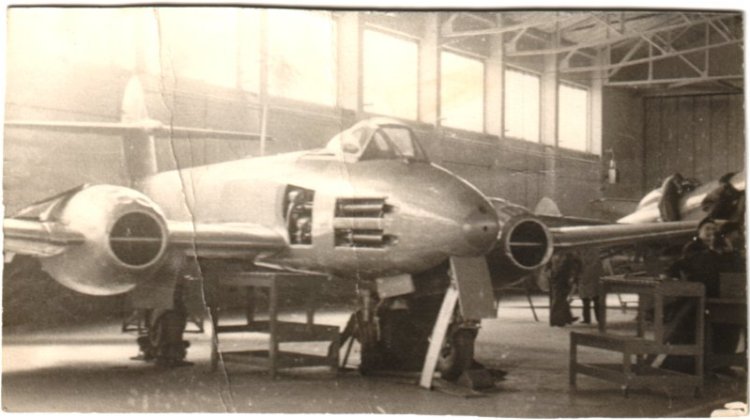|
Early Meteor
- I was told when given this photograph by Arthur Prescott that
it was around the end of the war at RAF Kirkham
After some deliberation
it looks like RAF Kirkham was an Armoury Apprentice School between
the latter part of the war and the late 1950's. This would explain
the instructional look of the aircraft, exposure of machine guns,
and mix of types together.
its interesting to read
through the thoughts as we first looked at the photo
johnb
I know for a
fact that Kirkham did have a Meteor as a gate guardian. The other
aircraft is interesting; it could be a Typhoon, but then it COULD
be a late version Spitfire, say a Mark XIV onwards, which had the
tear drop canopy.
Russell Brown
- 09/02
Location & general observations
There appear to be civilian workers present. The nearest unifomed
person seems to be holding something like a camera. Speculation:
During the war years the Civialian Repair organisation was very
effective and widespread and carried out work too difficult to handle
on bases etc., so could this be one of their locations? However,
I believe it was wound up very quickly after the end of hostilities.
If we're still at war here, it's unlikely that some erk would be
allowed free reign with a camera. So we have a dillema over time
- or, it narrows it down very much to just after end of war, say
2nd half of 1945?
Aircraft
The background subject, to me, has the "sit" of a Tempest
but the later versions of Typhoons had cut down rear fuselages and
bubble canopies. It really is nearly impossible to tell, other than
it is one of those 2 possibilities. The exhaust stack is just visible
at the edge of the photo. It looks to be set fairly high, so could
indicate a Tempest. It's difficult to tell whether it's camouflaged
or not (shiny patches etc make it very difficult to tell). If not,
again it might point to a Tempest as I don't recall seeing a "silver"
Typhoon photo.
Going back to the Meteor, I would agree early version (canopy and
fin shape). It doesn't appear to be camouflaged. If that's the case,
it again indicates very late war or early post-war. The early service
entrants were camouflaged to prevent observation on airfields by
reconnaisance aircraft. I don't think they were allowed out of the
country during the war, and I seem to recall that there were no
recorded Meteor vs Me262 combats (Me262 was faster and more manoeuvrable,
so it's just as well really). They were primarily used to chase
V1's. This aircraft has seen some use, and is obviously not ready
to fly. The starboard engine cowling has some nasty dents, and the
port cowling seems to have been removed altogether. The aircraft
is jacked up under the centre fuse and raised chocks on the main
wheels. However it looks as though it could be easily dropped down
and moved around the hangar. So it might not be redundant and for
ground use only at this stage. The lack of markings is a puzzle.
It could be one of several reasons; bad light on the photo, work
of the wartime censor, or the aircraft is in for heavy mainetenance
and has been stripped prior to re-painting (or polishing up the
natural metal). It could be just an instructional airframe.
Why have we got a Gloster and Hawker type aircraft together? Despite
my waffling above, it could be a RAF hangar because I don't think
a maintenance organisation would willingly mix types - they'd tend
to specialise.
Rob Chapman
- 09/02
|

